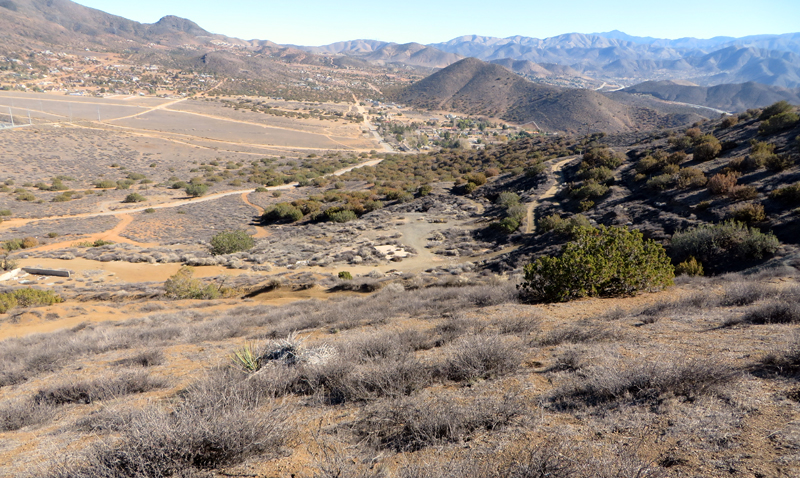|
|
Acton, California

Click image to enlarge
December 14, 2013 — The view to the east from the Governor Mine in Acton. By far the most productive gold mine in Los Angeles County in its heyday, the New York Mine (later called Governor Mine) was in production by the 1880s and was one of several Acton gold mines acquired by California Gov. Henry Gage, himself a New York transplant. Today its location can be described as off to the left (southwest) of the end of the paved portion of Governor Mine Road, which runs west off of Crown Valley Road in Acton. The mine is about a half-mile due east of the Red Rover Mine. Prior to Gage's ownership in 1895, the New York Mine had been operated by James O'Reilly who, two decades earlier, had run the portable grocery in "Soledad City" — the name used for small mining camps that moved from place to place within eastern Soledad Canyon in the 1860s. When the U.S. Postal Service refused to call the settlement "Soledad" (since there already was one elsewhere), it was O'Reilly who proposed the name Ravenna, for the saloon keeper Manuel Ravenna. The USPS made it official on June 12, 1868. It would be several more years before there was such a place as Acton. Townsfolk back then considered Ravenna their place of residence. According to John Robinson, noted historian of the San Gabriel Mountains (see Robinson 1973:27,30): The New York Mine ... was worked for a number of years with modest results. In 1889 it was acquired by James O'Reilly, a fiery red-haired Irishman. Under O'Reilly, the New York prospered. Several tunnels were drilled, the principal one being 800 feet long and reaching a vertical depth of 320 feet. A 5-stamp mill was erected to crush the ore. According to the State Mining Bureau's annual report for 1892, the ore returned from $10 to $25 per ton in gold. In 1895, the mine was purchased by Henry T. Gage, a lawyer-businessman closely allied with the Southern Pacific Railroad, and later governor of California (1899-1903). Gage's investment looked profitable at first, but in 1897 the gold-bearing vein pinched out and the mine was forced to close. But better days lay ahead. [...] [In the 1930s] Three mines of the Cedar Mining District remained active, off and on, into the 1950s. And two of these mines — the Governor (New York) and the Red Rover — have accounted for more than three-fourths of the total gold production in Los Angeles County since 1880. Governor Henry T. Gage's New York Mine was inactive from 1897 until 1932. In the latter year it was reopened by Francis Gage, the governor's son, and renamed the Governor Mine. During the ensuing years, it went through a period of intense activity. The main vertical shaft was deepened to 1,000 feet, and tunnels were drilled as long as 500 feet in each direction along the vein at vertical intervals of 100 feet. The California Division of Mines reported that these workings were the most extensive of any gold mine in Los Angeles County. Assays of several hundred dollars in gold per ton were made in high-grade shoots throughout the mine. Ore was crushed at the mine, then trucked to Acton to be milled at the Governor Mill. The period of greatest production was in the years 1937 to 1940. By 1940, production had increased to 140 tons of ore mined and milled every 24 hours. The mine was worked until October 1942, when Government wartime restrictions abruptly ended gold mining. The Bureau of Mines listed the total gold output of the Governor — from its development in the 1880s as the New York until its shutdown in 1942 — as more than $1,500,000 — almost three times the yield of any other gold mine in Los Angeles County. This was truly the bonanza king of the San Gabriel Mountains. Noting that little is left to remind modern visitors of Soledad's boom days, Robinson writes that now, "the wind whistles among the eroded diggings, the tailings and the scattered implements of the once fabulous Governor and Red Rover mines." But Robinson was writing in 1973. As we write this 40 years later, even those "scattered implements" are things of the past. According to adjacent property owners Lisa and Tim Smith (interview, 12-14-2013), within the last couple of years, the property owner (or possibly the claim holder) of the Governor Mine bulldozed the remaining equipment and debris into the mine shaft and closed it up with dirt.
LW2539w: 19200 dpi jpeg from digital image by Leon Worden. |
Related Categories:
|
The site owner makes no assertions as to ownership of any original copyrights to digitized images. However, these images are intended for Personal or Research use only. Any other kind of use, including but not limited to commercial or scholarly publication in any medium or format, public exhibition, or use online or in a web site, may be subject to additional restrictions including but not limited to the copyrights held by parties other than the site owner. USERS ARE SOLELY RESPONSIBLE for determining the existence of such rights and for obtaining any permissions and/or paying associated fees necessary for the proposed use.














